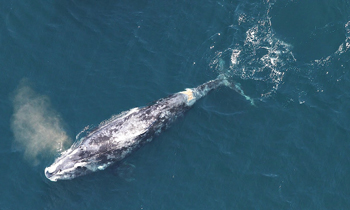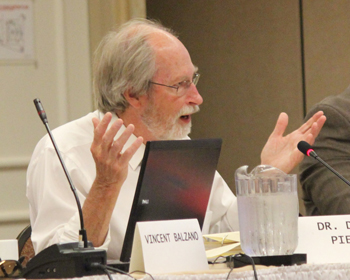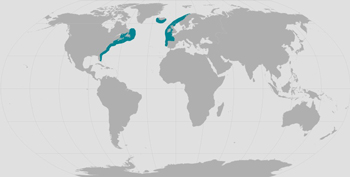Right Whale Decline:
“Who’s Accountable?”
By Laurie Schreiber

North Atlantic Right Whale. NOAA photo.
MYSTIC, Conn.—With the Atlantic Large Whale Take Reduction Team (ALWTRT) scheduled to meet April 23-26 and the National Marine Fisheries Service (NMFS) expected to move into rulemaking upon the meeting’s adjournment, members of the New England Fishery Management Council (NEFMC) wanted to know who will be held accountable if the endangered North Atlantic right whale population disappears.
“What happens if, on our watch, we lose the species?” NEFMC member Matthew McKenzie at NEFMC’s April 16 meeting. “Who’s held accountable for that?”
He added, “We were tasked with seeking to stop the decline of a whale population that has been on the decline for 40 years. We are now trying to develop reasonable measures while we’re looking at declining numbers of breeding females. The recent uptick of births is good news. But if we fail, what happens?”
NMFS marine mammal coordinator Michael Asaro said it’s NMFS’ responsibility.
“It’s on us to make sure that doesn’t happen,” said Asaro. “And we have the authority and the information we need to ensure it doesn’t happen.”
The exchange occurred during Asaro’s update to NEFMC on the latest proposals to mitigate risks to right whales.
The latest science shows that there were 411 right whales alive at the end of 2017. Of that, 100 were females, or potential mothers. Five calves were born in 2017 and zero in 2018. There’s been an uptick in 2019 of seven calves born. But 20 right whales are known to have died since 2017.
“If you look at serious injury and mortality over time, you can see we’ve never been able to achieve our goal of reducing that,” Asaro said.
Much of the fishing gear recovered from dead or entangled whales could not be identified as to origin, he said. However, he said, it’s known that there’s been an increased presence of Canadian fishing gear, particular snow crab gear, on entangled right whales since 2016, as observed first-hand in Canadian waters.
Asaro said the April 23-26 ALWTRT meeting will review proposals, work in groups to assess proposal elements, and assemble proposals. Mortalities and serious injuries from U.S. fisheries will likely need to be reduced by 60 to 80 percent from current levels. The team will refine proposals and work toward a consensus. NMFS will then move into rulemaking, based on the team’s recommendations, directly following the meeting’s adjournment, he said.

NEFMC member David Pierce wanted to know what would happen if the team’s consensus recommendation is not deemed to meet the projected 60 to 80 percent target. Michael Asaro, NOAA, said it’s then up to NMFS to put together measures to reach that target. Fishermen’s Voice file photo.
NEFMC member David Pierce wanted to know what would happen if the team’s consensus recommendation is not deemed to meet the projected 60 to 80 percent target.
Asaro said it’s then up to NMFS to put together measures to reach that target.
NMFS has not yet decided on a required level of risk reduction, he added.
In early April, Department of Marine Resources (DMR) Commissioner Patrick Keliher canceled a series of community meetings, designed to get industry information on the situation, due to what he wrote was NMFS’s lack of clarity.
“My intention for these meetings was to gather information from industry to inform state-specific plans for the Take Reduction Team to consider during its April 23-26 meetings, and to discuss options to advance at the Atlantic States Marine Fisheries Commission (ASMFC) meeting on April 29,” Keliher wrote. “However, the National Marine Fisheries Service continues to be unclear about the setting of a risk reduction target while introducing new methodologies and analyses that have the potential to significantly impact the content of the TRT and ASMFC discussions and any Maine-specific plans.
This is very alarming given the short timeline before the upcoming meetings and the potential for these last-minute analyses to propose modifications to the industry which could result in large-scale changes.”

North Atlantic Right Whale world habitat. NOAA map.
Keliher continued, “The state of Maine is willing to engage with NMFS to find solutions that protect North Atlantic right whales, but not in ways that would cause serious economic harm to the industry and the state. DMR will attend both the TRT meeting and the ASMFC Lobster Management Board Meeting to gather all necessary information about the target and possible options and will reschedule these industry meetings in the near future.”
He said his goal is to solicit industry ideas before NMFS takes final action.
Asaro said there are three general themes from the team’s proposals, as follows:
1. Reduce risk: reduce probability of entanglement
• New and modified seasonal closure
• Increase visibility of rope to whales (red line/sleeves)
• Continuation of vertical/water column line reduction strategy
• Trap caps and reductions as proxy
• Ropeless technology in new closure areas or new fisheries and aquaculture, or deep trap/pot fisheries
• Limits on new lines, especially in new closure areas, including aquaculture and experimental fisheries
• Remove/prevent new floating groundlines
2. Reduce impact: reduce severity of entanglements (serious injury or mortality)
• Reduce breaking strength:
• 1,700-pound breaking strength,
• rope diameter cap,
• 3/8-inch rope diameter,
• Weak sleeves
• Reduce surface system rope configuration
3. Inform Future Risk Reduction
• Gear Marking
• Weak sleeve, rope color and painting, improve visibility from aircraft and boats, increase stat/area specific marking, gear or target species marking, coastwide gear marking
• Monitoring and Reporting
• Vessel tracking, lost gear reporting
• Research
• Expansion of area covered by aerial and acoustic surveys, ropeless technology operational research.
“There’s no silver bullet on to how to fix this problem,” said Asaro. He later added, “For 20 years, we had 2-3 percent growth in this population. And we knew that things like U.S. ship strikes and entanglements and Canadian ship strikes and entanglements were all occurring….If you think through what it means to have a declining population of an endangered species, known human impacts makes the consultation process much more challenging.”
Council members noted that additional impediments have come about that impact the health of the right whale population, such as the use of low frequency sonar blasts tests in the gas and petroleum industry.
Asaro noted that developing new amendments to the right whale plan is a protracted process.
“It’s not something that’s immediate,” he said.
